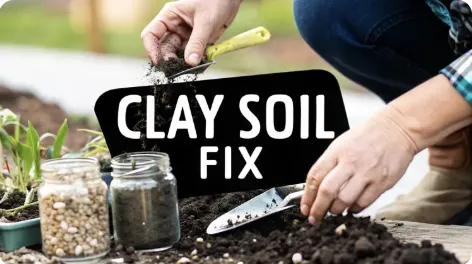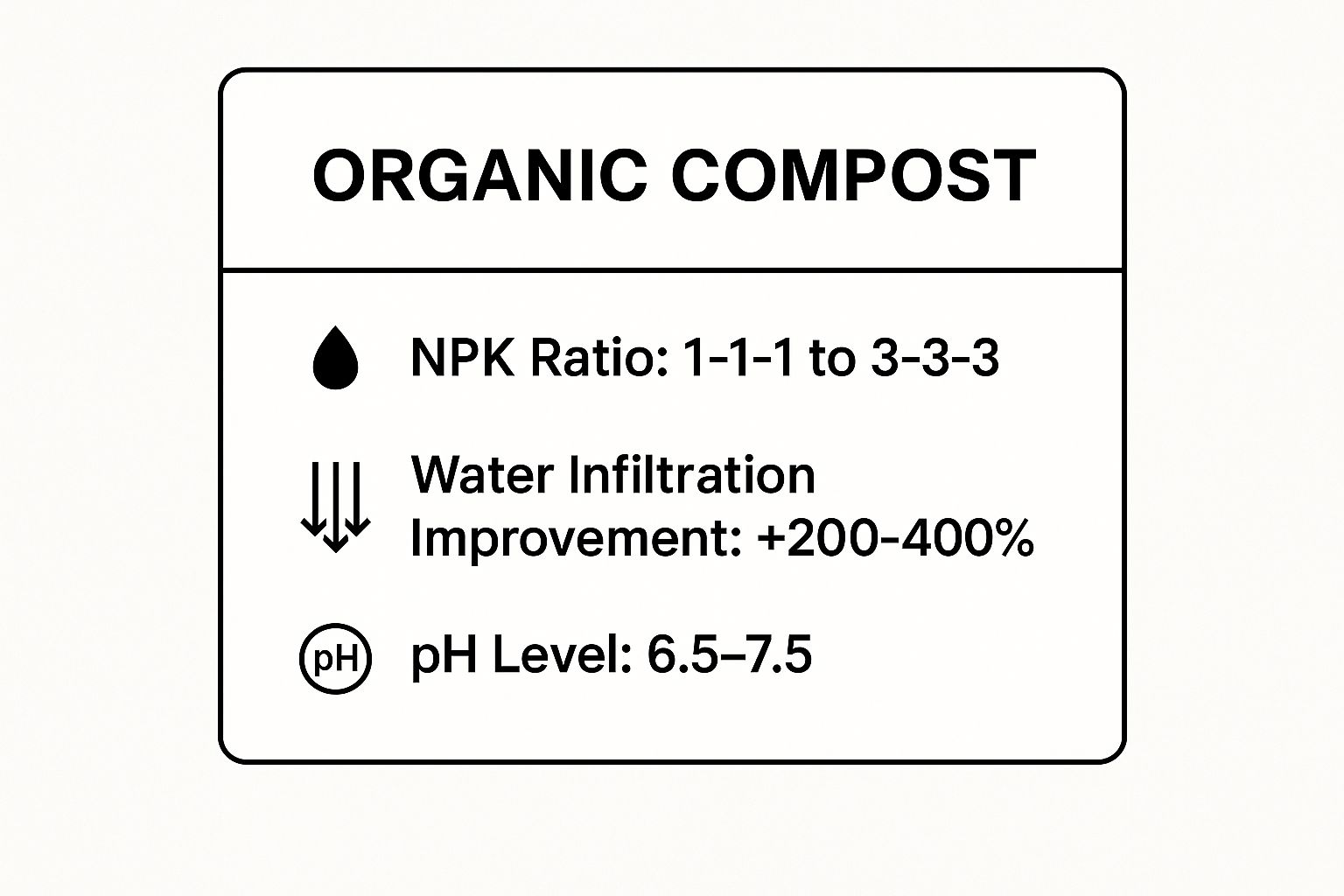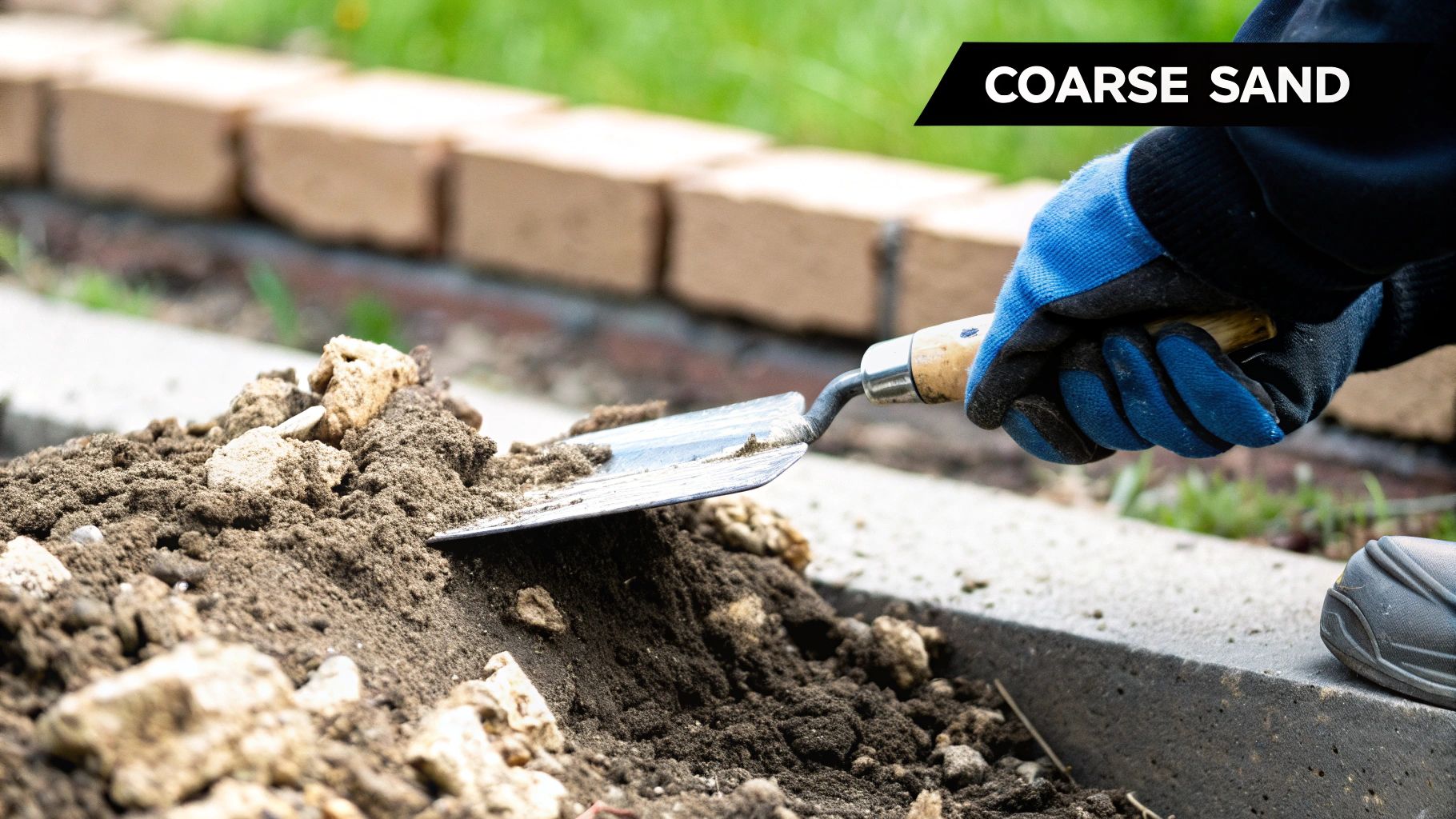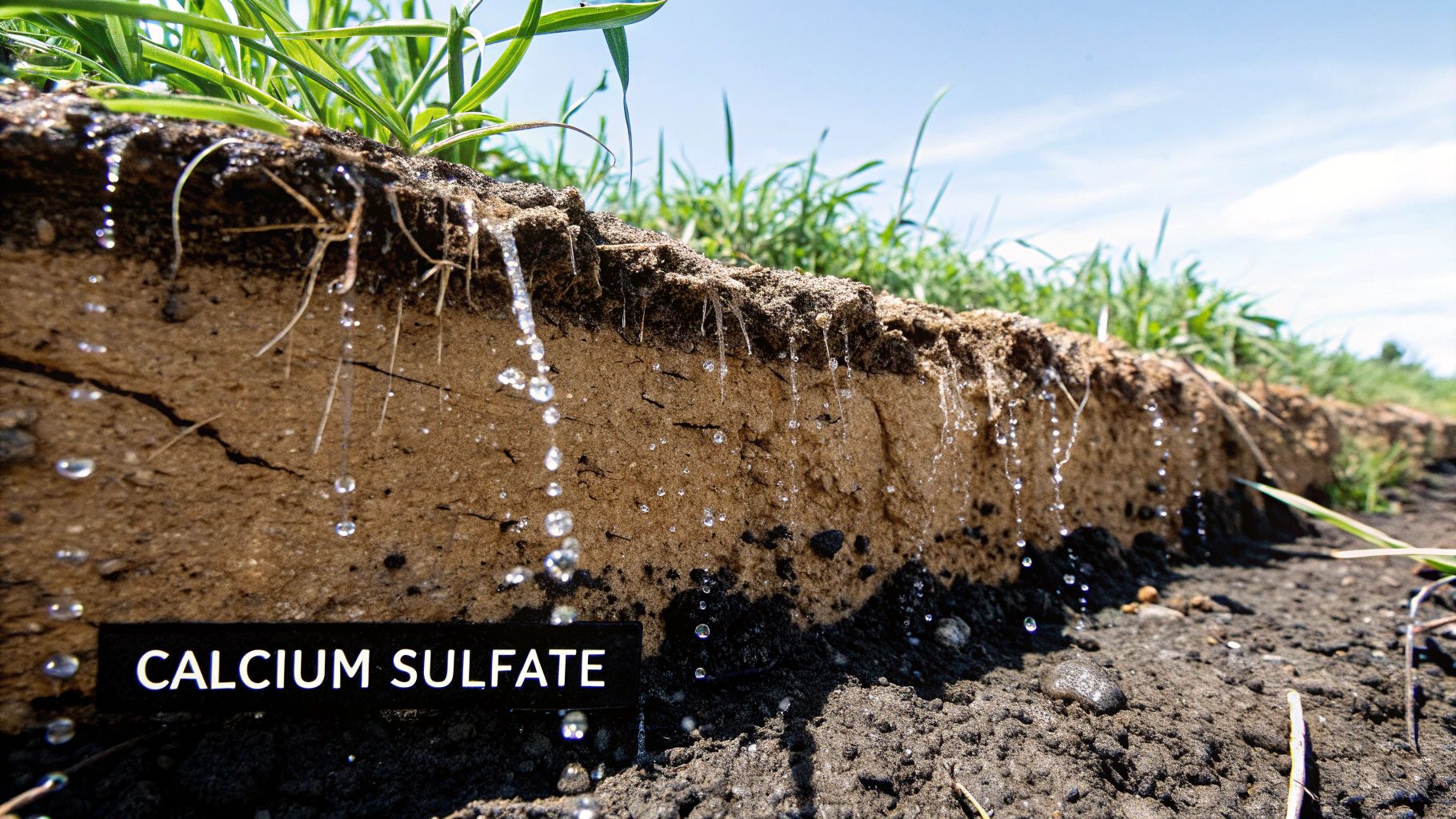
8 Best Soil Amendments for Clay Soil (2025 Guide)
8 Best Soil Amendments for Clay Soil (2025 Guide)
Struggling with compacted, waterlogged clay soil that feels more like pottery than a thriving garden bed? You're not alone. Clay soil, while naturally rich in nutrients, presents a unique challenge for gardeners and homesteaders. Its tiny, tightly packed particles can suffocate plant roots, prevent proper water drainage, and turn rock-hard when dry, making it difficult for plants to establish.
But don't reach for the shovel just yet. The secret isn't to replace your soil, but to transform it from within. By incorporating the right materials, you can dramatically improve its structure, aeration, and fertility, unlocking its full potential. This guide breaks down the best soil amendments for clay soil, moving beyond generic advice to provide a clear, actionable roadmap.
We will explore a curated list of top performers, from organic compost to expanded shale, detailing exactly how each one works to break up compaction. For each amendment, you'll find its specific benefits, potential drawbacks, and practical application rates to ensure your success. Let's get our hands dirty and build the foundation for your most productive garden yet by turning that stubborn clay into the black gold your plants will love.
1. Organic Compost
Organic compost is the undisputed champion when it comes to the best soil amendments for clay soil. This dark, crumbly material is the product of decomposed organic matter, teeming with billions of beneficial microorganisms. It acts as a powerful soil conditioner, physically altering the dense, sticky structure of clay.
When mixed into clay, compost introduces organic acids that bind the tiny, plate-like clay particles into larger, more stable aggregates. This process, known as flocculation, creates macropores (large air spaces) and micropores (small water-holding spaces). The result is a dramatic improvement in aeration, drainage, and root penetration, transforming heavy, unworkable soil into a friable and productive growing medium.
Why It Works for Clay Soil
Compost's effectiveness is well-documented. University of California extension programs have reported a remarkable 60% improvement in clay soil workability after just two years of consistent compost application. Similarly, commercial organic farms in California's Central Valley rely on compost to manage their heavy clay vineyard soils, ensuring proper root development and vine health.
Actionable Tips for Application
To get the most out of compost, follow these specific guidelines:
Apply Annually: Spread a 2 to 4-inch layer over your garden beds each year, preferably in the fall to allow winter weather to help work it in.
Incorporate Thoroughly: Mix the compost into the top 6 to 8 inches of your clay soil using a garden fork or tiller. Surface application is less effective for breaking up deep compaction.
Check for Quality: Finished compost should be cool to the touch and have a pleasant, earthy smell. If it's warm or has an ammonia-like odor, it hasn't fully decomposed and could harm your plants. If you're new to the process, you can learn more about how to make your own high-quality organic compost at home.
The infographic below offers a quick reference for the key metrics of high-quality compost.

These figures highlight compost's triple-threat capability: it provides balanced, slow-release nutrients, dramatically boosts water infiltration, and helps neutralize soil pH.
2. Coarse Sand (Builder's Sand)
Coarse sand, often sold as builder's sand, is a powerful mineral amendment used to permanently alter the physical structure of dense clay. Unlike fine play sand, which can mix with clay to create a concrete-like substance, coarse sand consists of large, angular particles (0.5-2mm). These larger particles create stable, lasting air pockets and drainage channels within the clay matrix.

When incorporated correctly, coarse sand physically separates the tiny clay platelets, preventing them from compacting together when wet. This amendment is one of the best soil amendments for clay soil when a long-term structural fix is needed, as the sand particles do not decompose over time. The result is a permanent improvement in aeration, water infiltration, and root-zone oxygen levels.
Why It Works for Clay Soil
The effectiveness of coarse sand is a foundational principle in high-performance turf management and professional landscaping. The United States Golf Association (USGA) has long established standards for using sand to construct resilient, well-draining golf greens on native clay soils. Likewise, landscapers in clay-heavy states like Texas and Georgia often create custom soil blends for raised beds using a mix of native clay, coarse sand, and compost to ensure plant success.
Actionable Tips for Application
To effectively use coarse sand without worsening your soil, follow these critical steps:
Use Only Coarse Sand: Never use fine sand, play sand, or beach sand. Insist on coarse, sharp-edged builder's sand to create the necessary air gaps.
Apply in Quantity: Spread a substantial 1 to 2-inch layer over the garden area. A light dusting will not be effective and may cause problems.
Combine with Organic Matter: Always add sand along with an equal amount of compost. Sand improves drainage, while compost adds fertility and moisture retention, creating a balanced soil.
Incorporate Deeply: Thoroughly mix the sand and compost into the top 6 to 8 inches of clay soil with a tiller or garden fork to integrate the amendments fully.
3. Aged Cow Manure
Aged cow manure is a time-tested soil amendment that offers a dual benefit for dense clay soils. As a well-decomposed organic material, it is rich in long-chain organic compounds and beneficial microbes. This makes it an excellent conditioner, physically breaking up compacted clay while simultaneously providing a balanced, slow-release source of essential plant nutrients.
When incorporated into the soil, aged manure functions similarly to compost. Its organic matter binds fine clay particles into larger, more stable aggregates. This structural improvement enhances aeration and water infiltration, preventing the waterlogging and root rot common in unimproved clay. The result is a richer, more workable soil that supports robust plant growth.
Why It Works for Clay Soil
Aged cow manure is particularly valued in agricultural settings with heavy soils. For instance, organic vegetable farms in Wisconsin often rely on aged dairy manure to manage their notoriously dense clay, reporting significant success in improving soil tilth and crop yields. Likewise, home gardeners in clay-heavy regions like Ohio have noted dramatic improvements in soil texture and plant health after just a couple of seasons of consistent manure application.
Actionable Tips for Application
To safely and effectively use aged cow manure, adhere to these key practices:
Ensure It's Fully Aged: Fresh manure is too high in nitrogen and salts, which can burn plant roots. Use manure that has been aged for at least 6 to 12 months. Properly aged manure will be dark, crumbly, and have an earthy smell.
Apply in the Fall: Spread a 2 to 3-inch layer over your garden beds in the fall. Incorporate it into the top 6 to 8 inches of soil, allowing the winter freeze-thaw cycles to help break down the clay and integrate the organic matter.
Source Carefully: Whenever possible, source manure from organic, pasture-raised cattle to avoid potential residues from herbicides, pesticides, or deworming agents that could harm your soil life and plants.
Test for Salts: If using a large quantity or a new source, consider testing the electrical conductivity (EC). High salt levels can be detrimental, and a test will confirm the manure is safe for your garden.
4. Perlite
Perlite is a unique mineral amendment, a type of volcanic glass superheated until it expands, creating an incredibly lightweight, porous, and sterile material. Often mistaken for styrofoam, these small white granules are rigid and don't break down over time, making them one of the best soil amendments for clay soil when seeking a permanent structural solution.
When incorporated into dense clay, perlite acts like tiny, non-biodegradable balls, creating a network of permanent air channels. This physical separation of clay particles prevents compaction and dramatically improves aeration and drainage. Unlike organic matter, it doesn't decompose, so its effect on soil structure is long-lasting, providing a reliable framework for root growth and water movement for years.
Why It Works for Clay Soil
Perlite's effectiveness is a cornerstone of the commercial horticultural industry. Professional greenhouse operations frequently amend their potting mixes with perlite to prevent waterlogging in containers, a principle that applies directly to heavy garden clay. Similarly, landscape contractors in regions with expansive clay, like parts of Texas and the Southeast, mix perlite into planting beds to ensure the long-term survival of expensive shrubs and trees by preventing root rot.
Actionable Tips for Application
To effectively use perlite for breaking up heavy clay, follow these specific guidelines:
Choose the Right Grade: Opt for medium or coarse grade perlite. Finer grades are less effective at creating the large air pockets needed to aerate dense clay.
Mix at the Correct Ratio: Incorporate perlite at a rate of 10-20% by volume. For a typical garden bed, this means adding one part perlite for every four to nine parts of soil.
Control Dust: Perlite can be very dusty. Lightly spray it with water before mixing it into your soil to minimize airborne particles.
Incorporate Deeply: To be effective, perlite must be thoroughly mixed into the top 6 to 10 inches of your soil. Simply layering it on top will not improve the underlying compaction.
5. Expanded Shale
Expanded shale is a unique and highly effective amendment, especially for creating permanent structural changes in heavy clay. This lightweight ceramic aggregate is produced by firing clay in a rotary kiln to over 2000°F (1100°C), causing it to expand and form a porous, stable material. It functions like a non-organic form of aeration, creating permanent air and water channels that will not decompose over time.
When incorporated into dense clay, expanded shale acts like a network of tiny sponges and tunnels. Its porous structure holds a remarkable amount of water and air, while its irregular shape physically separates the fine clay particles. This action prevents re-compaction and creates a stable, well-draining, and aerated soil structure that lasts indefinitely, making it one of the best soil amendments for clay soil requiring a long-term fix.
Why It Works for Clay Soil
Expanded shale’s permanence is its key advantage. Texas A&M AgriLife Extension has extensively researched and promoted its use, finding it dramatically improves drainage and aeration in the state's notoriously heavy clay soils. Professional landscapers and golf course designers in clay-heavy regions like Texas and Oklahoma frequently specify expanded shale in their soil mixes for turf, greens, and tree plantings to ensure long-term plant health and prevent root rot.
Actionable Tips for Application
To effectively use expanded shale, consider these professional-grade tips:
Aim for Volume: For significant structural change, incorporate expanded shale at a ratio of 20-30% of the total soil volume.
Incorporate Deeply: To create a robust root zone, mix the shale thoroughly into the top 8 to 12 inches of your clay soil using a tiller or shovel.
Combine with Organics: While shale provides permanent structure, it contains no nutrients. Always blend it with organic matter like compost to create a complete, fertile soil profile.
Source Locally: Expanded shale can be heavy and costly to ship. Check with local landscape supply yards or quarries to find regional producers and minimize transportation costs.
6. Gypsum (Calcium Sulfate)
Gypsum is a unique mineral amendment, also known as calcium sulfate, that chemically alters clay soil structure rather than just physically conditioning it. It works by introducing calcium, which displaces sodium ions attached to clay particles. This chemical exchange causes the fine clay particles to clump together, or flocculate, creating larger aggregates and improving soil structure.

Unlike lime, gypsum does not change the soil's pH, making it one of the best soil amendments for clay soil in regions where pH is already neutral or alkaline. This process dramatically enhances water infiltration, reduces crusting, and improves aeration, allowing plant roots to delve deeper and access more nutrients and water.
Why It Works for Clay Soil
Gypsum's effectiveness is particularly notable in sodic (high-sodium) and heavy clay soils, common in arid western regions of the U.S. For instance, California's almond orchards frequently use gypsum to break up restrictive hardpan layers, improving water penetration for healthier trees. Similarly, cotton farmers in the heavy clay soils of Texas rely on it to create a better seedbed and promote seedling emergence. It's a targeted solution for specific chemical imbalances in clay.
Actionable Tips for Application
For effective use, consider these specific guidelines for applying gypsum:
Test Your Soil First: Gypsum is most effective on sodic soils. A soil test will confirm if high sodium is your primary issue.
Application Rate: A general recommendation is 20 to 40 pounds per 1,000 square feet. Follow the specific instructions on the product packaging or your soil test results.
Incorporate and Water: Spread the gypsum evenly and work it into the top 4 to 6 inches of soil. Water the area thoroughly to help the calcium sulfate dissolve and begin the chemical reaction.
Timing is Key: Apply in the fall or early spring to give the mineral time to work before the peak growing season. Once your soil structure is improved, you can learn more about the best plants for clay soil to ensure a successful garden.
7. Pine Bark Fines
Pine bark fines are a fantastic, long-lasting amendment for breaking up heavy clay. These small, partially decomposed particles of pine bark, typically 1/4 to 3/8 inch in size, are more resistant to decay than compost or leaf mold. This structural integrity makes them one of the best soil amendments for clay soil when long-term aeration and drainage are the primary goals.
When incorporated into clay, pine bark fines create stable air pockets that do not collapse quickly. This physical separation of dense clay particles improves drainage, prevents waterlogging, and allows plant roots to access vital oxygen. Over time, they do decompose, slowly contributing valuable organic matter and a slightly acidic pH, which is ideal for many plants.
Why It Works for Clay Soil
The durability of pine bark fines is their key advantage. The nursery industry in the Southeastern United States, where heavy clay is common, has relied on pine bark for decades to create superior growing media. Furthermore, University of Georgia Extension programs often recommend pine bark fines for preparing garden beds in native clay, especially for acid-loving plants like azaleas and rhododendrons, which thrive with the improved structure and lower pH.
Actionable Tips for Application
To effectively use pine bark fines in your garden, consider these specific tips:
Apply the Right Amount: Spread a 2 to 4-inch layer of pine bark fines over the soil surface.
Incorporate Deeply: Mix the fines thoroughly into the top 6 to 8 inches of clay soil with a tiller or garden fork to ensure they create porosity where roots will grow.
Add Nitrogen: Fresh wood products can temporarily "tie up" soil nitrogen as they begin to decompose. Counteract this by adding a nitrogen-rich fertilizer, like blood meal or a slow-release granular option, during application.
Combine for Best Results: For a comprehensive soil improvement strategy, blend pine bark fines with an equal amount of finished compost. This combination provides both long-term structure and immediate microbial and nutritional benefits.
8. Leaf Mold
Leaf mold is a highly valued soil amendment made from decomposed leaves, long cherished in traditional gardening for its unique conditioning properties. Unlike compost, which is bacterially driven and nutrient-rich, leaf mold is created through a slower, fungal decomposition process. The result is a dark, crumbly, and wonderfully textured material that is particularly effective at improving the structure of heavy clay soil.
When incorporated into clay, the fibrous nature of leaf mold physically separates dense particles, creating essential air pockets for roots and water to move through. The extensive network of fungal hyphae it contains works to bind tiny clay particles into larger, more stable aggregates. This process significantly enhances soil tilth, aeration, and, most notably, water retention, making it one of the best soil amendments for clay soil when long-term structural improvement is the goal.
Why It Works for Clay Soil
Leaf mold's power lies in its ability to mimic the natural floor of a forest, a perfect model for soil health. European gardeners have utilized it for centuries to transform challenging clay substrates into workable, fertile beds. Many woodland garden specialists rely on leaf mold to create the ideal acidic, humus-rich conditions required for plants like rhododendrons and azaleas to thrive in otherwise dense clay. Its high carbon content feeds soil life without adding excessive nitrogen, which can harm some plants.
Actionable Tips for Application
To effectively use leaf mold to amend your clay soil, consider these specific tips:
Application Rate: Spread a 2 to 3-inch layer of finished leaf mold over your garden beds each fall. This timing allows winter moisture and frost cycles to help integrate it into the soil.
Incorporate Lightly: Gently work the leaf mold into the top 4 to 6 inches of soil with a garden fork. It also serves as an excellent mulch, slowly improving the soil from the surface down.
Speed Up Decomposition: To make your own, shred collected leaves with a lawnmower before piling them. This increases the surface area for fungi to work, reducing the decomposition time from two years to as little as one.
Maintain Moisture: Keep your leaf pile consistently moist, like a wrung-out sponge. If it dries out, the fungal activity will stop, halting the decomposition process. Preparing your garden soil correctly with amendments like leaf mold is a foundational step, and you can explore more about preparing garden soil here.
Top 8 Soil Amendments for Clay Soil Comparison

Your Next Steps to Healthier Soil and Abundant Harvests
Transforming heavy, compacted clay soil into a thriving garden bed is a journey of patience and consistent effort. As we've explored, there is no single magic bullet. Instead, lasting success comes from a thoughtful and layered strategy, combining the unique strengths of various amendments to create a truly balanced and fertile growing medium.
The Power of a Combined Approach
The most critical takeaway is the synergy between different types of amendments. While inorganic materials provide immediate and lasting structural improvements, organic matter is the lifeblood that fuels your soil's ecosystem over the long term.
For Instant Aeration: Amendments like expanded shale, perlite, and pine bark fines are your go-to solutions for creating air pockets and drainage channels right away. They physically separate the tiny clay particles, preventing compaction and allowing roots, water, and air to penetrate deeper.
For Long-Term Fertility: The true foundation of healthy soil is built with organic matter. Compost, aged manure, and leaf mold not only improve structure as they decompose but also feed the beneficial microorganisms that make nutrients available to your plants. This is the key to building a resilient, self-sustaining garden ecosystem.
Think of it as building a house. The inorganic amendments are the frame and foundation providing permanent structure, while the organic matter is the insulation, wiring, and plumbing that make it a living, functional home for your plants. A strategic blend, such as mixing compost with expanded shale, offers both immediate relief from compaction and sustained biological activity.
Your Action Plan for Better Clay Soil
Feeling overwhelmed? Don't be. The most important step is simply to start. You don’t need to use every amendment on this list. Choose what is most accessible and practical for your situation and begin the process.
Your First Steps:
Assess Your Goal: Are you trying to fix a waterlogged lawn or build a brand-new vegetable bed? For lawns, topdressing with compost and gypsum might be best. For a new garden bed, tilling in a combination of aged manure and coarse sand will provide a robust start.
Start Small: Focus on one garden bed or a specific problem area first. This makes the task more manageable and allows you to observe the results of your efforts before expanding.
Commit to Consistency: The journey to improving clay soil is a marathon, not a sprint. The best soil amendments for clay soil are the ones you apply consistently. Make it a seasonal habit to top-dress your beds with a fresh layer of compost or leaf mold each fall or spring. This annual addition of organic matter is non-negotiable for maintaining soil health.
By embracing this process, you are not just amending soil; you are cultivating a legacy of fertility. You are building a foundation that will reward your efforts with stronger plants, more abundant harvests, and a deeper connection to the land you tend. The work you do today will pay dividends for many seasons to come.
Ready to take your homesteading and gardening skills to the next level? At The Grounded Homestead, we provide practical guides, in-depth tutorials, and proven strategies for building a more self-sufficient life, starting from the ground up. Visit The Grounded Homestead to discover more resources on everything from soil science to sustainable food production.


Facebook
Instagram
X
Youtube